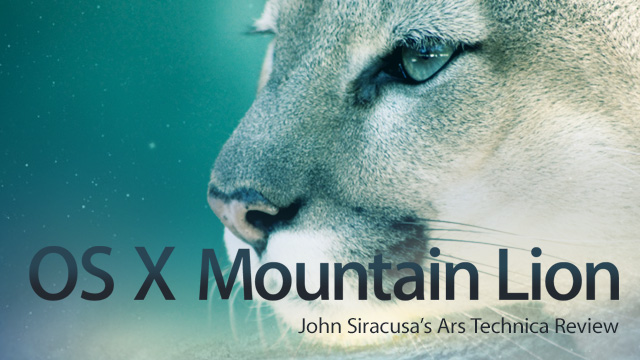
Apple's traditional desktop computing business has suffered many indignities over the past decade. Once Apple's flagship product line, the Mac first found itself playing second fiddle to the iPod—a mere music player—in the early 2000s. Today, matters are worse; on a graph of Apple's revenues, the Mac now appears as a thin strip of earth while iOS devices are the mountain that sits upon it.
Apple presented last year's release of OS X 10.7 Lion as part of a turn "back to the Mac." Ostensibly, the tagline was Apple's promise to bring innovations from its mobile operating system back to Mac OS X. But more broadly, it also meant that the Mac would receive more of Apple's attention.
That attention resulted in some dramatic changes to aspects of the operating system that had not been reconsidered in decades: application launching, the document model, process management—even basics like window resizing and scrolling. As Apple's newly refocused gaze fell upon its desktop operating system, many parts of it were deemed archaic and unworthy of continued existence.
At the end of last year's Lion review, I concluded: "[Lion] marks the point where Mac OS X releases stop being defined by what's been added. From now on, Mac OS X should be judged by what's been removed." Unfortunately, the surgery was not a complete success. There were… complications.
Sins of the father
Apple's intentions were noble. Lion's new features said all the right things: "Stop worrying about saving your documents; Lion's got you covered. You don't need to keep track of how many applications are running; let the OS handle those details for you. Don't bother mucking around in the Finder, your applications are only a few clicks away. And scroll bars? Getting them out of your face is like a breath of fresh air. Trust me, this is going to be awesome."
Some longtime Mac users rejected Apple's premise that these things needed to be fixed. I am not among them—nor, I suspect, are the many millions of people who have been introduced to Apple through an iOS device. For most people, the problems Apple tried to address in Lion were real. The solutions, however, had some rough edges.
And then there were the bugs—oh, the bugs! It's been common for 10.x.0 releases of Mac OS X to have bugs related to new functionality. These bugs are usually fixed quickly, with most disappearing in the 10.x.1 and 10.x.2 releases. Lion differed in both the nature and longevity of its bugs. Bugs in basic functionality like WiFi connectivity and Web browser stability bedeviled many Lion users, and it took Apple several releases over many long months to address the worst of them.
The theme underlying nearly all of Lion's changes was that the Mac could learn a thing or two from iOS. This theme didn't just influence the conceptual foundations of the OS (e.g., that users should not have to worry about saving documents or conserving resources by quitting applications), it also reached all the way up to specific details of the user interface and graphical design (e.g., the newly skeuomorphic versions of iCal and Address Book).
These user-visible changes also met with much resistance—again, some of it knee-jerk, but much of it justified, especially in cases where the changes significantly reduced functionality or made features more difficult to find.
Second bite at the apple
Enter OS X 10.8 Mountain Lion. Apple made a half-hearted attempt to brand 10.7 as "OS X Lion," but the "Mac" prefix was far from completely expunged at launch. This is the first of many areas where Mountain Lion aims to succeed where its predecessor failed, so "OS X Mountain Lion" it is—emphatically, universally, with a bullet.
The final piece of Apple's renewed focus on the Mac is the uncharacteristically pre-announced move to annual releases of OS X. So not only did Mountain Lion have to correct Lion's missteps, it had only one year of development time to do so. Furthermore, unlike the last OS X release that just added a modifier to its predecessor's name, Mountain Lion doesn't have the luxury of focusing solely on refinement and internal changes. It has to move the ball forward… hopefully with fewer fumbles than Lion.
But hang on a second. For a desktop OS in the year 2012, which direction is "forward," anyway? The obvious answer is "toward iOS," but Lion proved that it's not quite that simple. And really, there has to be more to it than compulsive imitation, otherwise why continue development of the Mac platform at all?
Mountain Lion is Apple's answer to all these questions. It is the digital manifestation of Apple's belief that the Mac is still relevant, that it can be made better than it was before. In some ways, I feel the same as I did over a decade ago when considering a new version of OS X: I want to believe.
reader comments
276